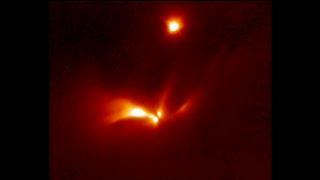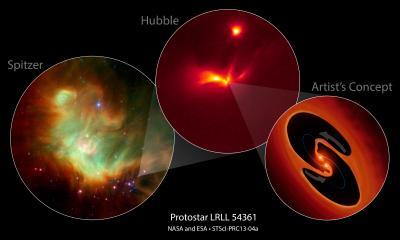The Spitzer infrared data, collected repeatedly during a period of seven years, showed unusual outbursts in the brightness of the suspected binary protostar. Surprisingly, the outbursts recurred every 25.34 days, which is a very rare phenomenon.
Astronomers used NASA's Hubble Space Telescope to confirm the Spitzer observations and reveal the detailed stellar structure around LRLL 54361. Hubble observed two cavities above and below a dusty disk. The cavities are visible by tracing light scattered off their edges. They likely were blown out of the surrounding natal envelope of dust and gas by an outflow launched near the central stars. The disk and the envelope prevent the suspected binary star pair from being observed directly. By capturing multiple images over the course of one pulse event, the Hubble observations uncovered a spectacular movement of light away from the center of the system, an optical illusion known as a light echo.
Muzerolle and his team hypothesized the pair of stars in the center of the dust cloud move around each other in a very eccentric orbit. As the stars approach each other, dust and gas are dragged from the inner edge of a surrounding disk. The material ultimately crashes onto one or both stars, which triggers a flash of light that illuminates the circumstellar dust. The system is rare because close binaries account for only a few percent of our galaxy's stellar population. This is likely a brief, transitory phase in the birth of a star system.
Muzerolle's team next plans to continue monitoring LRLL 54361 using other facilities including the European Space Agency's Herschel Space Telescope. The team hopes to eventually obtain more direct measurements of the binary star and its orbit.

This video, created from a sequence of images from the Hubble Space Telescope, shows a pulse of light emanating from the protostellar object LRLL 54361. Most if not all of this light results from scattering off circumstellar dust in the protostellar envelope. An apparent edge-on disk, visible at the center of the object, and three separate structures are interpreted as outflow cavities. The extent and shape of the scattered light changes substantially over a 25.3-day period. This is caused by the propagation of the light pulse through the nebula. Astronomers propose that the flashes are due to material in a circumstellar disk suddenly being dumped onto the growing stars and unleashing a blast of radiation each time the stars get close to each other in their orbit. The false-color, near-infrared light photos are from Hubble's Wide Field Camera 3.
(Photo Credit: NASA, ESA, and J. Muzerolle (STScI) and G. Bacon (STScI))

NASA's Spitzer and Hubble space telescopes have teamed up to uncover a mysterious infant star that behaves like a police strobe light.
(Photo Credit: NASA, ESA, J. Muzerolle (STScI), E. Furlan (NOAO and Caltech), K. Flaherty (Univ. of Ariz./Steward Observatory), Z. Balog (Max Planck Institute for Astronomy), and R. Gutermuth (Univ. Mass. Amherst)Image acknowledgment: R. Hurt (Caltech/Spitzer Science Center))
Source: NASA/Goddard Space Flight Center